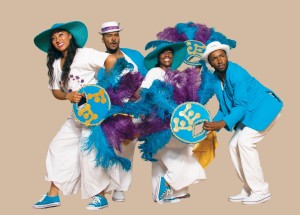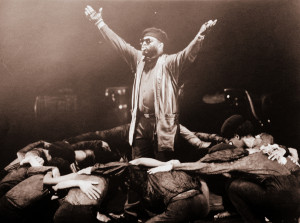The City of Oakland became a hot bed of cultural awareness and political and social activism for the African American community during the 1960’s and 1970’s. As a result, several historically significant organizations opened their doors and launched programs that uplifted and educated the African American community by responding to the community’s social, political, economic and cultural needs. Marcus Bookstore, the nation’s oldest African American owned bookstore, opened its Oakland store in 1960; the Black Panther Party launched its revolutionary campaign in 1966; and the oldest African American dance company on the West Coast, Dimensions Dance Theater (DDT), began its artistic legacy in December 1972.

Photo by Earl Bickman
Dimensions’ lineage extends deep into the history and legacy of Black dance in the United States. Deborah Vaughan, cofounder and artistic director of DDT, began her dance journey in the Oakland recreation department’s dance program studying modern and Haitian with the program’s founder Ruth Beckford; Beckford in turn studied and performed with the renowned Katherine Dunham, before going on to become the first Black member of Anna Halprin and Welland Lathrop’s respective dance companies. Although best known for her presentations of Caribbean dance in American cinema—Carnival of Rhythm, Cabin in the Sky and Star Spangled Rhythm—and for developing the eponymous Dunham Technique, Dunham’s greatest contribution to the field may owe to her work as an anthropologist. She influenced scores of dancers, including the founders of Dimensions, to study the technique of dance within the context of the larger culture from which it comes.
“I was researching the similarities in African American dance forms and their connections to ethnic specific dance forms in West Africa,” Vaughan says. “Elendar [Barnes] and I traveled to Africa, the Caribbean and throughout the United States to understand more about the contributions that had been made to Black dance styles and how they got to the Americas,” she continues. Never expecting their advisors would agree (they were told they had to use undergraduate dance students), the two Mills College graduate students used their Berkeley High students to whom they taught Haitian and modern dance for their thesis concert. The success of the concert led to inquiries about future performances. “So we formed the company in December 1972. Then people wanted to study and dance with the company, so we formed the school,” Vaughan fondly remembers.
Due in large part to the cultural awakening sparked by the Civil Rights and Black Power movements, in which the Black Panthers and Marcus Bookstore played a major role in Oakland, African Americans were hungry to learn about their ancestry. Dimensions Dance Theater was created to answer this demand by preserving and perpetuating African and African derived dance forms that reflect the lives and experiences of African Americans. This mission statement later evolved to include the experiences of Africans throughout the diaspora.
To ensure the young company could fulfill its mission, the co-directors, Vaughan and Barnes, along with Shirley Brown, who joined the company in 1974, insisted company dancers train in ballet, modern, jazz, and Haitian. This decision set the company apart from the other companies that had formed around the same time (Wajumbe and Citicentre Dance Theatre). “Studying various dance forms enabled me to draw on different movement vocabularies to tell my stories and express my vision,” Vaughan states proudly. The company’s method of training dancers afforded it the opportunity to present mixed programs, the first ever on the West Coast. In any given performance, an audience member would see modern, jazz, and Haitian.
Existing 40 years as an African American dance organization comes with more challenges than not—limited resources, economic downturns, lack of adequate space, doubt. For many years, Dimensions faced nay sayers who insisted that no one company could present artistic excellence in more than one genre of dance: “How do dance companies with specific ethnic roots cope with a theatrical world that demands a high degree of entertainment value as well as respect for tradition and interest in modern art form?” questioned former San Francisco Chronicle dance critic Marilyn Tucker in a 1986 review of the company. This sentiment echoed across funding panels through the early 90’s, which often affected the company’s ability to raise money.
To those sentiments Vaughan responded, “I don’t want to be put in a box; I want to express my artistic vision through the various dance forms I’ve studied. As African Americans, we sit in a very special position where we can study different diasporic forms. As African Americans, that movement information still resides in our cellular construct; the ability to learn and survive unforgiving circumstances and supersede expectations courses through our blood. So yes, we can perform and excel and present different dance forms or a fusion thereof on the same program.”
Anchored in the strength and validity of its mission, Dimensions forged ahead, fortifying its relevance through its continued responsiveness to community needs: the company participated in Community of Black Dance, an organization created in the 1970’s to support Black dance instructors teaching modern, jazz, and Haitian in the public schools and at the college level. The company established a long-term partnership with Marcus Bookstore in Oakland, using the store located on Martin Luther King, Jr. Way near 40th as a place for the community to purchase advance tickets for performances. To enlighten school age children about the influences of African dance on American culture, Dimensions developed From Africa to America, a lecture demonstration that traces the history of dance from Africa to America. A small ensemble of dancers performed traditional African dance, modern dances based on Negro spirituals, and jazz dance to show their similarities. When hip hop emerged, the dancers incorporated this newly formed African American dance style to include contributions of the younger generation.

Photo by: Umi Vaughan
It didn’t stop there. The year after the company moved into the then redeveloped Alice Arts Center (1993), now known as the Malonga Casquelourd Center for the Arts, Dimensions launched Rites of Passage. “I couldn’t find any quality arts programs for my children,” Vaughan states. “Knowing what it means to gain confidence, self-esteem, and discipline through dance education, I wanted to provide the same opportunity for Oakland’s youth,” she continued, remarking on her experiences in Oakland Parks and Recreation’s dance program. “I had to give back to the community that raised me in dance.” Now approaching its 20th year, ROP, as it is fondly known, provides young people the opportunity to learn from master artists rooted in traditional artistic forms strongly interwoven within African American culture. More importantly it also helps students to work collectively and develop a deeper sense of themselves so they become positive and productive community members.
Event after monumental event has provided artistic fodder for the company to examine and create works of art that reflect the grand possibilities of life as human beings through the lens of the African experience. Dimensions repertory includes works that paid tribute to a variety of still topical issues like: Black Power and Black Arts Movements. The company’s first piece, My People (1973), choreographed by Barnes, was an ode to the beauty in Blackness. Set to the Langston Hughes poem of the same name, My People was the first piece performed by an African American dance company in the Bay Area to live recitation. Civil Rights Movement: To March, created in 1992 in collaboration with a capella singing group Street Sounds and actor Winston Williams, brought to life familiar and not so familiar stories of the Civil Rights movement such as the speeches Martin Luther King, Jr. delivered regarding the Vietnam War. Apartheid: People of the Zozos, an incredible collaboration with South African trumpeter Hugh Masekela, examined the everyday lives of South Africans residing in Shanty towns and the similarities to Jim Crow South (1991). This work premiered a year after the South African government freed Nelson Mandela. Black Panther Party: Vaughan collaborated with former Black Panthers, to celebrate the Party’s 30th anniversary. Project Panther premiered in 1996 as the first interdisciplinary piece to acknowledge the important contributions the Panthers made to Oakland and ultimately the nation. The Rodney King verdict/death of Latasha Harlins: Dimensions reached out to Lily Cai Chinese Dance company to create Common Ground in 1994 with hopes of showing both communities of people the similarities of their cultures through dance. Black on Black crime epidemic/Hip Hop: The esteemed Dimensions on stage with a hip hop group? Why not? Seen Scenes featured the hip hop flows and storytelling of urban griots The College Boyz. Drawing on traditional West African dance and spirituality, modern dance and hip hop, this work revisions the tragedy of a drive-by shooting, demonstrating how communities can right societal ills by utilizing ancestral knowledge.
Now 40 years strong, Dimensions continues to create work that pulls communities together. Down the Congo Line, the culmination of which will premiere October 5, bridges four communities, Brazilian, Congolese, African American and Cuban through their Congolese lineage. This multiyear collaboration, one of several, reinforces the company’s purpose to preserve and perpetuate African and African derived dance forms. With the continued dedication of the company members, community and the strength of the organization’s artistic offerings, Dimensions definitely has another 40 years coming.
This article appeared in the September 2013 issue of In Dance.


